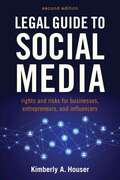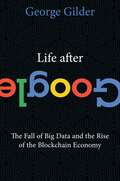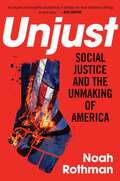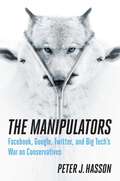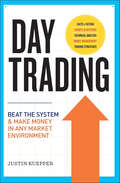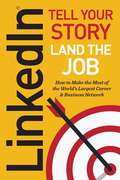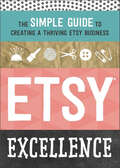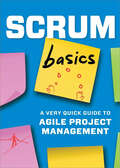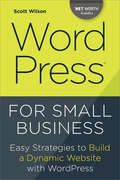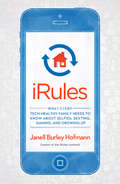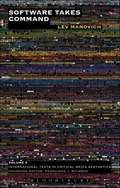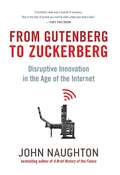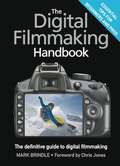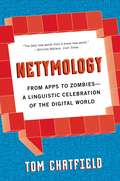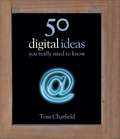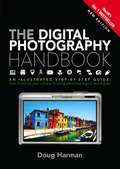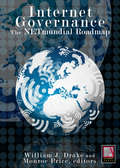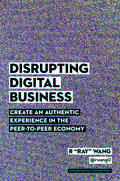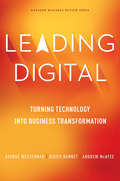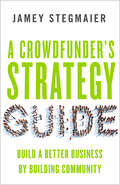- Table View
- List View
Legal Guide to Social Media, Second Edition: Rights and Risks for Businesses, Entrepreneurs, and Influencers
by Kimberly A. HouserLearn how to navigate the ins and outs of the law and social media. How should you respond to a request to remove copyrighted materials from a Facebook page? If you create a Twitter username at work, who owns the username when you change jobs? Can you be sued for libel if someone thinks your posts are defamatory? If you&’ve ever asked yourself these kinds of questions, this pioneering legal handbook is for you. Despite the enormous growth in social media usage by businesses and influencers, very little has been written about the laws affecting their activities. In this new edition of the Legal Guide to Social Media, Kimberly A. Houser, law professor and tech attorney, explains the potential pitfalls and how to avoid them including what social media influencers could have done to protect themselves from the lawsuits resulting from the Fyre Festival debacle. Easy-to-understand, comprehensive, and up-to-date, the Legal Guide to Social Media, Second Edition provides the latest information on case law and statutes. It covers everything from privacy laws to the legal considerations in setting up a page or website as well as new governmental regulations. This plain English legal companion offers examples of and solutions to the kinds of situations you can expect to encounter when posting online content, whether for yourself, your own business, or on behalf of your client&’s business. You&’ll learn how to avoid liability for defamation and third-party posts, how to protect your own content, the unique legal issues surrounding social media in the workplace, and much, much more. The new edition covers new state regulations on privacy, data security and advertising; how to avoid intellectual property infringement actions; and the newer legal risks for influencers.
Life After Google: The Fall of Big Data and the Rise of the Blockchain Economy
by George Gilder“Google’s algorithms assume the world’s future is nothing more than the next moment in a random process. George Gilder shows how deep this assumption goes, what motivates people to make it, and why it’s wrong: the future depends on human action.” — Peter Thiel, founder of PayPal and Palantir Technologies and author of Zero to One: Notes on Startups, or How to Build the Future. “If you want to be clued in to the unfolding future, then you have come to the right place. For decades, George Gilder has been the undisputed oracle of technology’s future. Are giant companies like Google, Amazon, and Facebook the unstoppable monopolistic juggernauts that they seem, or are they dysfunctional giants about to be toppled by tech-savvy, entrepreneurial college dropouts?” — Nick Tredennick, Ph.D., Chief Scientist, QuickSilver Technolog Silicon Valley’s Nervous Breakdown The Age of Google, built on big data and machine intelligence, has been an awesome era. But it’s coming to an end. In Life after Google, George Gilder—the peerless visionary of technology and culture—explains why Silicon Valley is suffering a nervous breakdown and what to expect as the post-Google age dawns. Google’s astonishing ability to “search and sort” attracts the entire world to its search engine and countless other goodies—videos, maps, email, calendars….And everything it offers is free, or so it seems. Instead of paying directly, users submit to advertising. The system of “aggregate and advertise” works—for a while—if you control an empire of data centers, but a market without prices strangles entrepreneurship and turns the Internet into a wasteland of ads. The crisis is not just economic. Even as advances in artificial intelligence induce delusions of omnipotence and transcendence, Silicon Valley has pretty much given up on security. The Internet firewalls supposedly protecting all those passwords and personal information have proved hopelessly permeable. The crisis cannot be solved within the current computer and network architecture. The future lies with the “cryptocosm”—the new architecture of the blockchain and its derivatives. Enabling cryptocurrencies such as bitcoin and ether, NEO and Hashgraph, it will provide the Internet a secure global payments system, ending the aggregate-and-advertise Age of Google. Silicon Valley, long dominated by a few giants, faces a “great unbundling,” which will disperse computer power and commerce and transform the economy and the Internet. Life after Google is almost here. For fans of "Wealth and Poverty," "Knoweldge and Power," and "The Scandal of Money."
Media Madness: Donald Trump, the Press, and the War over the Truth (Regnery Publishing Ser.)
by Howard Kurtz"‘Defiance Disorder’: Another new book describes chaos in Trump’s White House"–Ashley Parker, Washington Post According to the media, Donald Trump could never become president. Now many are on a mission to prove he shouldn’t be president. The Trump administration and the press are at war—and as in any war, the first casualty has been truth. Bestselling author Howard Kurtz, host of Fox News’s Media Buzz and former Washington Post columnist, offers a stunning exposé of how supposedly objective journalists, alarmed by Trump’s success, have moved into the opposing camp. Kurtz’s exclusive, in-depth, behind-the-scenes interviews with reporters, anchors, and insiders within the Trump White House reveal the unprecedented hostility between the media and the president they cover.In Media Madness, you’ll learn: Why White House strategist Steve Bannon told Trump he is in danger of being impeached How the love-hate relationship between the president and Morning Joe hosts—Joe Scarborough and Mika Brzezinski—turned entirely to hate How Kellyanne Conway felt betrayed by journalists who befriended her—and how she fought backHow elite, mainstream news reporters—named and quoted—openly express their blatant contempt for Trump How Bannon tried to block short-lived Communications Director Anthony Scaramucci—and why Trump soured on himHow Ivanka and Jared Kushner aren’t the liberals the pundits want them to be—and why Trump tried to discourage them from joining the White House Why Trump believes some journalists harbor hatred for him—and how some liberals despise his voters How Trump is a far more pragmatic politician than the press often acknowledges (and how the press dismisses his flip-flops when he flops their way) What Trump got wrong about Charlottesville—and how Steve Bannon predicted the debacle How the media consistently overreached on the Russian “collusion” scandal Why Trump actually likes journalists, secretly meets with them, and allows the press unprecedented access Why Reince Priebus couldn’t do his job—and the real reason he left the White House How Sean Spicer privately berated journalists for bad reporting—and why he and Kellyanne Conway were relentlessly attacked by the mediaNever before has there been such an eye-opening, shocking look at what the White House and the media think about each other. It’s not pretty. But it also makes for the most important political book of the year.
Unjust: Social Justice and the Unmaking of America
by Noah Rothman"An elegant and thoughtful dismantling of perhaps the most dangerous ideology at work today." — BEN SHAPIRO, bestselling author and host of "The Ben Shapiro Show" "Reading Noah Rothman is like a workout for your brain." — DANA PERINO, bestselling author and former press secretary to President George W. Bush There are just two problems with “social justice”: it’s not social and it’s not just. Rather, it is a toxic ideology that encourages division, anger, and vengeance. In this penetrating work, Commentary editor and MSNBC contributor Noah Rothman uncovers the real motives behind the social justice movement and explains why, despite its occasionally ludicrous public face, it is a threat to be taken seriously. American political parties were once defined by their ideals. That idealism, however, is now imperiled by an obsession with the demographic categories of race, sex, ethnicity, and sexual orientation, which supposedly constitute a person’s “identity.” As interest groups defined by identity alone command the comprehensive allegiance of their members, ordinary politics gives way to “Identitarian” warfare, each group looking for payback and convinced that if it is to rise, another group must fall. In a society governed by “social justice,” the most coveted status is victimhood, which people will go to absurd lengths to attain. But the real victims in such a regime are blind justice—the standard of impartiality that we once took for granted—and free speech. These hallmarks of American liberty, already gravely compromised in universities, corporations, and the media, are under attack in our legal and political systems.
The Manipulators: Facebook, Google, Twitter, and Big Tech's War on Conservatives
by Peter J. HassonFor better or for worse, Google and social media—&“Big Tech,&” collectively—have become the new public square. Unfortunately, this public square has a watchful referee standing behind them, ready and waiting to blow the whistle if they veer too far from the preferred narrative. Americans have given these companies enormous power to select the information they read, share and discuss with their neighbors and friends. We&’ve gotten so used to it, we forget to notice that Big Tech is sifting through the available information and narrowing—and prioritizing—our choices. What happens when that power is weaponized for political ends? Although Big Tech positioned itself initially as providing politically neutral platforms, the truth is that this is no longer the case—far from it. Daily Caller reporter Peter Hasson reveals in The Manipulators that Big Tech is using its huge financial and technological power to severely restrict access to conservative voices and ideas and to rig public debate in favor of America&’s political left wing. This happens in two ways: 1) By censoring and suppressing right-of-center voices and ideas, which restricts access to information that counters the progressive narrative 2) By purposefully amplifying left-wing voices and ideas, which creates the false impression that public consensus lines up with progressive orthodoxy.
Social Media and the Internet
by Meg GreveFilled with popular childhood themes and experiences, Social Media and the Internet features kid friendly, real world examples. Practical tips spark lively, meaningful conversations about social media and the internet.
The Power Of Off: The Mindful Way To Stay Sane In A Virtual World
by Nancy ColierOur reliance on technology is rapidly changing how each of us experiences life. We’re facing new issues and difficulties, we’re encountering new emotional triggers, and we’re relating to each other in new ways. As Dr. Nancy Colier writes, "How we spend our time, what motivates us, and what we want are all are on a radical course of transformation." The promise of technology is that it will make our lives easier; yet to realize that promise, we cannot be passive users—we must bring awareness and mindfulness to our relationships with our devices. "The compulsion to constantly check our devices plays on primal instincts," teaches Colier. "Even people with strong spiritual practices or those who have never had other addiction issues now find themselves caught in the subtle trap of these miraculous tools we’ve created." Through The Power of Off, she offers us a path for making use of the virtual world while still feeling good, having healthy relationships, and staying connected with what is genuinely meaningful in life. You’ll explore: How and why today’s devices push our buttons so effectively, and what you can do to take back control of your life • Tips for navigating the increasingly complex ways in which technology is affecting our relationships—with ourselves, others, and our devices themselves • Self-evaluation tools for bringing greater awareness to your use of technology • Mindfulness practices for helping you interact with your devices in more conscious ways • A 30-day digital detox program to kick-start a new healthier relationship with technology With The Power of Off, Colier sounds the call for wakefulness, reminding us that we can use technology in a way that promotes, rather than detracts from, our well-being. This book provides an essential resource for anyone wanting to create a more empowered relationship with technology in the digital age.
Day Trading: Beat the System and Make Money in Any Market Environment
by Justin KuepperAll You'll Ever Need to Trade from Home When most people hear the term "day trader," they imagine the stock market floor packed with people yelling 'Buy' and 'Sell' - or someone who went for broke and ended up just that. These days, investing isn't just for the brilliant or the desperate—it's a smart and necessary move to ensure financial wellbeing. To the newcomer, day trading can be a confusing process: where do you begin, and how can you approach trading in a careful yet effective way? With Day Trading you'll get the basics, then: Learn the Truth About Trading Understand The Psychology of Trading Master Charting and Pattern-recognition Study Trading Options Establish Trading Strategies & Money Management Day Trading will let you make the most out of the free market from the comfort of your own computer.
LinkedIn: Tell Your Story, Land the Job
by Jeff Norman<p>Meet the World's Largest Career and Networking Site: LinkedIn <p>LinkedIn is dominating the world of business-based networking, yet many of its users don't know how to make the most of it, while others are hesitant to join yet another social network. Whether you're a job seeker, an employer in search of new talent, or a business looking to boost your visibility, make LinkedIn your social network of choice, this book your guide. <p><i>LinkedIn: Tell Your Story, Land the Job</i> will help you: <p> <li>Learn tips and tricks for building a strong LinkedIn profile, optimized for discovery <li>Write a concise professional summary, gather endorsements and recommendations, and highlight your skills <li>Create a virtual hub for current and potential employees and customers <li>Take advantage of LinkedIn's Company Pages to improve your visibility <li>Dig deeper into LinkedIn's offerings, by getting the most out of introduction requests, advanced search, media tools, and professional groups <li>Explore the pros and cons of the free vs. paid versions of LinkedIn</li> <p> <p>Dust off your LinkedIn Profile and make it shine with this visual, easy-to-follow handbook.</p>
Etsy Excellence: The Simple Guide to Creating a Thriving Etsy Business
by Tycho PressThe Ambitious Crafter's Guide to a Profitable Etsy ShopMore than a marketplace, Etsy is a community—and being an active, informed member can lead to lucrative results. This book provides actionable steps to help shop owners engage the Etsy community in authentic ways that attract buyers and generate sales.The best Etsy shops stand out among the sea of sellers and a draw loyal customer base, but how they've done it isn't—and shouldn't be—a secret. In these pages, top Etsy sellers share the tools that have helped them, the changes they made that yielded positive results, and their best advice for achieving and sustaining a successful Etsy shop.Beyond sellers' words of wisdom, this book offers a roadmap all Etsy sellers can follow in order to:- Choose keywords and tags to drive traffic to your Etsy shop - Photograph your products for maximum appeal - Create a unique Etsy shop that stands out - Write winning product descriptions - Price your goods appropriately - Market your products effectively on social media platforms - Maintain lasting relationships with your Etsy customers - Diversify your Etsy product offerings
Scrum Basics: A Very Quick Guide to Agile Project Management
by Tycho PressThe Elements of Agile and Scrum in a Nutshell Whether you're new to agile software development or considering Scrum for general project management, Scrum Basics compiles all of the essentials into one handy little guide. Learn how agile teams use Scrum, with: A simple summary of agile project management basics like the Agile Manifesto and 12 Agile Principles A concise overview of Scrum roles, artifacts, and activities A well-organized breakdown of Scrum practices with helpful illustrations and advice A troubleshooting FAQ and 5 case studies to help you visualize Scrum in action
WordPress for Small Business: Easy Strategies to Build a Dynamic Website with WordPress
by Scott WilsonYour New Home on the Internet is Waiting Once upon a time, if you owned a local bakery, you didn't need a website. Now every bakery, car wash, dentist's office, and nail salon has a website—and they need one in order to survive. If you already understand your primary business, then your hard work is done. WordPress for Small Business will show you the rest. With step-by-step instructions and full-color screenshots, WordPress for Small Business helps you understand the WordPress options that are best for you, and shows you how to quickly build a dynamic web site that will improve your business. Step-by-step instructions with full-color screenshots Real-life examples of WordPress success stories Quiz to find out what type of WordPress site you need A guide to the principles of modern website architecture Pro tips for SEO, e-commerce, themes, widgets, and plugins WordPress for Small Business gives you everything you need to expand your business online.
iRules: What Every Tech-Healthy Family Needs to Know about Selfies, Sexting, Gaming, and Growing up
by Janell Burley HofmannAs Janell Burley Hofmann, mother of five, wrapped her 13-year-old's iPhone on Christmas Eve, she was overwhelmed by questions: "Will my children learn to sit and wonder without Googling? Should I know their passwords for online accounts? Will they experience the value of personal connection without technology?"To address her concerns, she outlined boundaries and expectations in a contract for her son to sign upon receiving his first cell phone. When Hofmann's editor at The Huffington Post posted the contract, now known as iRules, it resonated on a massive scale and went viral, resulting in a tsunami of media coverage and requests. It quickly became apparent that people across the country were hungry for more.In iRules, Hofmann provides families with the tools they need to find a balance between technology and human interaction through a philosophy she calls Slow Tech Parenting. In the book, she educates parents about the online culture tweens and teens enter the minute they go online, exploring issues like cyberbullying, friend fail, and sexting, as well as helping parents create their own iRules contracts to fit their families' needs. As funny and readable as it is prescriptive, iRules will help parents figure out when to unplug and how to stay in sync with the changing world of technology, while teaching their children self-respect, integrity, and responsibility.
Software Takes Command
by Lev ManovichSoftware has replaced a diverse array of physical, mechanical, and electronic technologies used before 21st century to create, store, distribute and interact with cultural artifacts. It has become our interface to the world, to others, to our memory and our imagination - a universal language through which the world speaks, and a universal engine on which the world runs. What electricity and combustion engine were to the early 20th century, software is to the early 21st century. Offering the the first theoretical and historical account of software for media authoring and its effects on the practice and the very concept of 'media,' the author of The Language of New Media (2001) develops his own theory for this rapidly-growing, always-changing field. What was the thinking and motivations of people who in the 1960 and 1970s created concepts and practical techniques that underlie contemporary media software such as Photoshop, Illustrator, Maya, Final Cut and After Effects? How do their interfaces and tools shape the visual aesthetics of contemporary media and design? What happens to the idea of a 'medium' after previously media-specific tools have been simulated and extended in software? Is it still meaningful to talk about different mediums at all? Lev Manovich answers these questions and supports his theoretical arguments by detailed analysis of key media applications such as Photoshop and After Effects, popular web services such as Google Earth, and the projects in motion graphics, interactive environments, graphic design and architecture. Software Takes Command is a must for all practicing designers and media artists and scholars concerned with contemporary media.
From Gutenberg to Zuckerberg: What You Really Need to Know About the Internet
by John NaughtonJohn Naughton is the Observer's 'Networker' columnist, a prominent blogger, and Vice-President of Wolfson College, Cambridge. The Times has said that his writings, "[it] draws on more than two decades of study to explain how the internet works and the challenges and opportunities it will offer to future generations," and Cory Doctrow raved that "this is the kind of primer you want to slide under your boss's door." In From Gutenberg to Zuckerberg, Naughton explores the living history of one of the most radically transformational technologies of all time. From Gutenberg to Zuckerberg is a clear-eyed history of one of the most central, and yet most taken-for-granted, features of modern life: the internet. Once a technological novelty and now the very plumbing of the Information Age, the internet is something we have learned to take largely for granted. So, how exactly has our society become so dependent upon a utility it barely understands? And what does it say about us that this is so? While explaining in highly engaging language the way the internet works and how it got to be the way it is, technologist John Naughton has distilled the noisy chatter surrounding the technology's relentless evolution into nine essential areas of understanding. In doing so, he affords readers deeper insight into the information economy and supplies the requisite knowledge to make better use of the technologies and networks around us, highlighting some of their fascinating and far-reaching implications along the way.From the Hardcover edition.
The Digital Filmmaking Handbook
by Chris Jones Mark BrindlePart of the perennially best-selling Quercus Digital Photography series, this comprehensive guide features everything you need to know to make a digital film, from conception to finished product. Using clear, step-by-step instruction, The Digital Filmmaking Handbook concisely illustrates the technical and creative challenges of digital filmmaking for novices and professionals alike, spanning topics from conception to execution: - Planning a shoot: how to make a storyboard - Set preparation: dressing and lighting a set - Principal photography: filming with HD and DSLR cameras--including the latest advice on equipment, accessories, and software - Advanced editing: software and practices - Post-production: digital effects and Packed with tips and tricks to develop both your creative vision and your technical know-how, The Digital Filmmaking Handbook is the ultimate resource for all your filmmaking needs. From the Trade Paperback edition.
Netymology: A Linguistic Celebration of the Digital World
by Tom ChatfieldComposed of 100 bite-sized entries of 400 to 600 words each, Netymology weaves together stories, etymologies and analyses around digital culture's transformation and vocabulary. Chatfield presents a kaleidoscopic, thought-provoking tour through the buried roots of the symbols, speech, and mannerisms we have inherited from the digital age: from the @ and Apple symbols, to HTML and Trojan horses, to the twisted histories of new forms of slang, memes, text messages and gaming terms; how language itself is being shaped by technology, how it is changing us.
50 Digital Ideas You Really Need to Know
by Tom ChatfieldWe are in the throes of a revolution, yet most of us are so disorientated by the rapid pace of technological and cultural change that we find it difficult to understand what's going on. 50 Digital Ideas you Really Need to Know aims to provide a clear path through the confusion and misinformation surrounding those technologies that, for better or for worse, are transforming the world we live in and even the sort of people we are.Leading technology writer Tom Chatfield is a sure-footed guide to the seminal digital phenomena of our time, from the basic browsers that we use to surf the web and update our status on social networking sites, through to the implications for privacy of our permanently distracted world, to the culture jamming that is making it increasingly difficult for traditional power structures to impose their authority. Whether plumbing the depths of the deep web that represents well over 99 percent of the internet and remains inaccessible to most search engines, to digital distribution which threatens to sweep away entire industries, to the augmented reality that will soon change the very way we interact with the world, this is an indispensable road map for the inevitable journey to a digital future.From malware to mashups; from spam to the semantic web; and from email to avatars, this book is essential reading for anyone who wants to understand the profound social and behavioural changes wrought by the emerging digital age.
Digital Photography Handbook
by Doug Harman David JonesIn the last few years digital cameras and "digital darkrooms" in the form of computers and image manipulation software have revolutionized modern photography. Truly professional results are tantalizingly within reach of all--and The Digital Photography Handbook shows you how to combine photographic flair with digital expertise to achieve them. Part one looks at the cameras, the lenses and other hardware accessories, explains the technology behind them and helps you choose exactly what you need. Part two explores the art of photography itself, from composing a shot to considerations such as depth of field, focus or exposure. It also examines a series of themes such as landscapes, weddings and holidays providing tips and ideas for how to photograph them. Part three moves into the "digital darkroom". Here, expert instruction will give you the confidence to correct common problems and get the most out of your images, while a series of masterclasses focuses on professional image manipulation techniques and artistic effects, breaking them down into step-by-step stages for you to follow. Finally, part four looks at printing your photographs--whether to paper or on to the web. For those interested in taking their photography a little further, it explores building a portfolio and offers advice on copyright and selling your pictures.In this new, updated edition Doug Harrman includes the very latest developments in digital technology, equipping you with everything you need to become an accomplished 21st-century photographer.
Catfish
by Nina FoxxBest Friends Dana and Damika share everything about each other, because that's what best friends do, right? But when it comes to relationships, the high schoolers are keeping secrets in cyberspace. After Boy Crazy Dana meets the "perfect" guy, she figures the only way to get close is to tell little white lies. As their relationship flourishes, an inappropriate photo sent for his eyes only...ends up going viral, and threatens Dana's reputation and her future. Tech nerd Damika is able to reinvent herself online and she's created a cyber life that no one knows about but her. When she meets Rosheon, she's thrilled at their budding relationship, until she discovers there's a lot more to him than meets the eye because just as she can reinvent herself....so can others. As the lies become unmanageable, can Dana and Damika dig themselves out of a web of a mess before it's too late? In this page-turning novel, Nina Foxx dives into a world where nothing is as it seems and danger takes on new meaning in cyberspace.
Internet Governance: The NETmundial Roadmap
by Monroe E. Price Patrick Ryan Larry Gross Arlene Luck Joana Varon Ferraz Matthew Shears Ronaldo Lemos Vint Cerf Emma Llansó William J. Drake Max Senges Shawn Powers Jeremy Malcolm Lea Kaspar Nnenna Nwakanma Anriette Esterhuysen Avri Doria Samantha Dickinson Wolfgang Kleinwächter Richard Whitt Markus Kummer James Losey Marilia Maciel"Following up on the promise of the NETMundial meeting, this timely and useful book explores the challenges of implementing its roadmap for the future of Internet governance." -- Milton L. Mueller, Professor, Syracuse University School of Information Studies, USAInternet Governance: The NETmundial Roadmap explores key implications of the Global Meeting on the Future of Internet Governance held on April 23-24, 2014 in São Paulo, Brazil. At the meeting, government, business, civil society, Internet technical community and academic participants from around the world agreed to a "NETmundial Multistakeholder Statement" that included a "Roadmap for the Future Evolution of Internet Governance." This volume brings together leading practitioners and scholars to explore the challenges of implementing the Roadmap's section on institutional improvements, and was prepared for release and debate at September 2014 global Internet Governance Forum in Istanbul. The 16 chapters are grouped into six sections: Overviews; Strengthening the Internet Governance Forum; Filling the Gaps; Improving ICANN; Broader Analytical Perspectives; and Moving Forward. The book was produced as a part of the Internet Policy Observatory, a program at the Center for Global Communication Studies, the Annenberg School for Communication at the University of Pennsylvania. It is edited by William J. Drake of the University of Zurich and Monroe Price of the Annenberg School for Communication.
Disrupting Digital Business
by R Ray" WangWe are no longer an economy of products and services. The digital transformation demands that we focus our attention on experiences and outcomes. Business leaders and their organizations must shift to keeping promises-no matter how their customers interact with them.But organizations no longer control the conversation. In this era of social and mobile technology, customers, employees, suppliers, and partners are in direct communication with one another. Those personal networks and the brands they're passionate about influence their decision making and their spending.The workforce has changed too. Employees expect to be able to determine when and how they will work, the technology they'll use, and the values their company will espouse.Organizations can take part in this conversation only if they recognize how and where it's happening. Resisting these changes will leave executives, managers, and their companies powerless. Organizations must pivot with and ahead of these social, organizational, and technological shifts or risk being left behind.Technology guru Ray Wang shows how organizations can surf the waves of change-how they can keep their promises. Current trends, when taken seriously, require a new way of thinking about business that includes five key areas:1. Consumerization of technology and the new C-suite2. Data's influence in driving decisions3. Digital marketing transformation4. The future of work5. Matrix commerceDigital disruption has changed how we do our work. But by mastering these trends you'll delight your customers with every interaction.
Leading Digital: Turning Technology into Business Transformation
by George Westerman Andrew Mcafee Didier BonnetLeading Digital makes the provocative argument that the next imminent phase of digital technology adoption - driven by the convergence of mobility, analytics, social media, cloud computing, and embedded devices - will make everything that’s happened so far look like a prelude. The authors, a trio of highly regarded thought leaders on corporate digital transformation, say changes in the digital realm so far have focused on high tech and media companies - but there’s still a whopping 94% of the business economy that needs to change. This book will show them how. George Westerman of MIT, Didier Bonnet of Capgemini Consulting, and Andrew McAfee, also at MIT, say there is opportunity for these businesses to learn from those that have already mastered the digital landscape. Based on a study of more than 400 large, mainstream firms in every industry around the globe, the authors usefully break down how these organizations have used their own digital transformation to gain strategic, competitive advantage. Readers will learn how these digital leaders have transformed their businesses through smart and rigorous digital investments, and through smart and effective leadership of the change. Leading Digital offers practical, real-life tested frameworks that can be instantly applied. Case studies include Nike, Caesars, Burberry, Asian Paints, Pages Jaunes, Codelco, and more.
The Eudaemonic Pie
by Thomas A. BassA classic story about beating roulette with the world's first wearable computers. "A veritable piñata of a book," said The New York Times, which ranges from the invention of personal computers through the history of gambling to breaking the bank in Las Vegas. "Bass has done the best job so far of capturing the marriage of technical imagination and communal coziness that gave rise to Silicon Valley," said the Los Angeles Times. "An extraordinary story," said Nature. "Behind the fun and games there lies an economic parable for the decade just passed." A madcap adventure and insanely comedic, this is "an astonishing and fascinating tale of scientific heroism," said Richard Dawkins.
A Crowdfunder's Strategy Guide: Build a Better Business by Building Community
by Jamey StegmaierMore Than MoneyJamey Stegmaier knows crowdfunding. He's a veteran of seven successful Kickstarter campaigns (and counting) that have raised over $3.2 million, and he's the proprietor of the widely read Kickstarter Lessons blog. In this book he offers a comprehensive guide to crowdfunding, demonstrating that it can be a powerful way for entrepreneurs to grow their businesses by building community and putting their customers first.This book includes over forty stories of inspiring successes and sobering disasters. Stegmaier uses these examples to demonstrate how to (and how not to) prepare for a campaign, grow a fan base, structure a pitch, find new backers, and execute many other crucially important "nuts and bolts" elements of a successful crowdfunding project.But Stegmaier emphasizes that the benefits of crowdfunding are much more about the "crowd" than the "funding." He shows that if you treat your backers as people, not pocketbooks—communicate regularly and transparently with them, ask their opinions, attend to their needs—they'll become advocates as well as funders, exponentially increasing your project's chances of succeeding.
